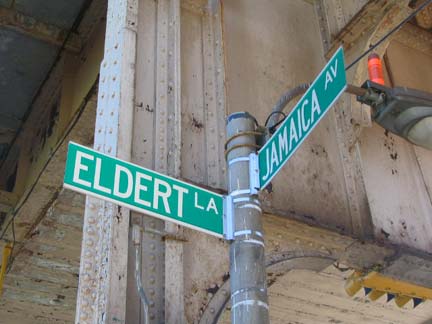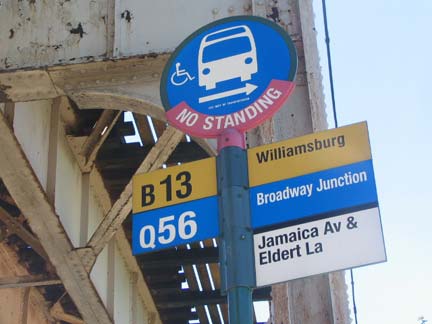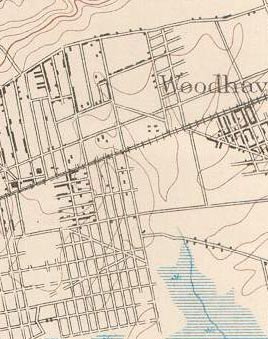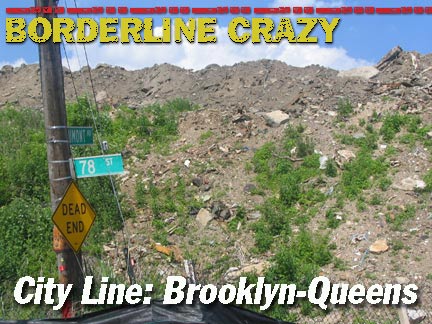THE BRONX borders Nassau County.Manhattan borders Queens. The Bronx borders Queens, too. Staten Island borders Middlesex County, New Jersey. Suffolk County borders Rhode Island! But these worlds never truly come together, since all those borders are on water.
Not so with Brooklyn and Queens: these twins are conjoined, land-locked through Ridgewood, the Cemetery Belt, in an overlooked section in Brooklyn’s far east and Queens’ far west named City Line, since until 1898 Brooklyn was a city of its own.
At all times, the border is undefended. But these are two different lands indeed, and things can be uneasy. A walk down the border will illustrate how.
Google map of Cypress Hills/City Line



The border runs down the middle of a streetthat cartographers over the years have not decided what, exactly, to call. Newer maps and street signs proclaim it Eldert Lane, while the elevated train station above Jamaica Avenue calls it Elderts Lane; undoubtedly there was an Eldert at one time, and it began as Eldert‘s Lane. Lastly, it was known as Enfield Streetfor a few decades in the early 20th Century.

Eldert Lane runs north-south from Cypress Hills, in the north, south to City Line. Between Jamaica Avenue and 95th Avenue, it runs along the Brooklyn-Queens border, which runs down he center of the street. Houses on the west side of the street carry Brookly addresses, even numbers beginning with 2. Houses on the east side carry Queens addresses, beginning with 87-01.
This 1891 topographical map shows Eldert Lane running north to south in the center. Rockaway Road, which became Rockaway Blvd., angles off to the southeast at the top of the map, while Old South Road does the same at the bottom.
Map from University of New Hampshire.
Franklin K. Lane High School, Elderts Lane station
Eldert Lane, looking south from 88th Avenue (formerly Syosset Street)
Eldert Lane is one of 17 streets that border both Brooklyn and Queens. The others are Onderdonk Avenue, Flushing Avenue, Cypress Avenue, Menahan Street, St. Nicholas Avenue, Gates Avenue, Wyckoff Avenue, Irving Avenue, Interborough Parkway, Robert Street, 95th Avenue, Drew Street, Liberty Avenue, 75th Street, Dumont Avenue and 78th Street.
It wasn’t always quite so complicated. Look at the 1913 map here: while it’s likely that many of these streets were paper streets and did not yet exist, the borough line was drawn in a straighter fashion, and in the south followed Spring Creek, which came as far north as Liberty Avenue.
In the 1920s, the lines were redrawn along streets, likely to avoid houses being in two boroughs and two post offices at once.
Map from Brooklyn Genealogy.
Presbyterian Church of the Redeemer, Etna Street and Eldert Lane
Until the 1950s, Karweg Place, a short, rutted alley between Grant Avenue and Eldert Lane, was called Liberty Place. Why change to Karweg? Could they have been anticipating its anagram…
Ahhhh..I doubt it.
Rockaway Boulevard, looking southeast from Eldert Lane
Rockaway Boulevard, looking northwest toward Eldert Lane
Eldert Lane is a relatively short street but it witnesses the birth and death of two important Brooklyn and Queens thoroughfares. Rockaway Boulevard, originally known as Rockaway Road going back to the late 18th and early 19th Centuries, here begins its lengthy journey to the Rockaway peninsula. The name of the boulevard goes back to the Native Americans; the Rockaway, and their main settlement Rechqua Akie, were centered in what is now Far Rockaway, Queens, the east end of the peninsula. After the Governor Kieft war against Native Americans in 1645, many Rockaway moved to northern New Jersey; while after other land disputes with other Native American groups and the english in the 1680s, many members repaired to Patchogue, Long Island, where Rockaway are found today.
The other end of Rockaway Boulevard, at least in Queens, is in Meadowmere.
1998
2005
While staggering around Woodhaven (the Queens neighborhood just east of City Line) in the summer heat in 1998 I discovered a fascinating abandoned diner at Rockaway Blvd. and 91st Avenue that appeared to have been hastily deserted: the dishes were still piled up on the counter awaiting washing, with a hand-lettered sign on the door saying “closed due to illness”; varying accounts named it the Bluebird, or simply, Carl’s. What a fascinating ancient slice of Queens this was. Alas, in the age of overdevelopment, “fascinating” and “unique” are dirty words to people who want to realize maximum value on property, and the nail that sticks up is quickly hammered down. It wasn’t easy to squeeze a boring, window-challenged frame house in this space, but it can be done, as this picture shows. We’ll leave the former abandoned diner site to its newfound mediocrity and hope the homeowners are happy.
Eldert Lane and Fulton Street looking west
Eldert Lane and 91st Avenue looking east
I have mentioned that Eldert Lane is the spawning ground and killing floor for some major throughfares, and we’ve already seen the beginning of Rockaway Boulevard. Just a block south is the end of Fulton Street, Brooklyn’s main shopping street, at least on its western end, and the dividing line of several neighborhoods including Crown Heights, Bedford-Stuyvesant, Clinton Hill and Prospect Heights. It also determines several of Brooklyn’s street systems, as all the avenues named for New York State cities, like Albany, Troy, Schenectady, etc. Avenues have their northern ends at Fulton, while several Bedford-Stuyvesant Avenues, Marcy, Tompkins, Throop, have their southern ends on this street, which was named in the early 1800s for steamboat pioneer Robert Fulton.
Through much of the late 19th and early 20th Centuries most of Fulton Street was shrouded under two elevated train lines, the Fulton Street el, which ran from the waterfront then down Van Sinderen and Snediker Aveues. Fulton Street then enjoyed a block of sunshine before another el, the one running down Broadway from Williamsburg and Bushwick and out to Jamaica, covered it again. That line is still extant and indeed, some of its 1870s steelwork can still be found above Fulton just east of Jamaica avenue.
The only part of Fulton that enjoyed any sun at all was the 6 blocks of its run in Cypress Hills, as the el turns north on Crescent Street. That is the section we see here. East of Eldert Lane, Fulton Street’s roadbed continues as 91st Avenue, while its name does not. To add somewhat to the confusion, part of Jamaica Plank Road, later Jamaica Avenue, was known as Fulton Street for lengthy sections well into the 1800s (Jamaica Avenue begins at Fulton St. in Brooklyn where it meets Pennsylvania Avenue.)
The last building on Fulton Street, #3480, is the old W.M. Evans Dairy.
95th Avenue looking east from Eldert Lane
Eldert Lane crosses busy Atlantic Avenue, under which busy LIRR main line tracks tunnel, and the Brooklyn-Queens line turns east at 95th Avenue. This was a pivotal intersection for me in the 1970s and 80s. Till about 1998, you could find at this corner a vintage 1940s T-Pole mast, complete with original incandescent lamp and fire alarm light mounted below its crossbar. After I posted the lamp on a FNY page, the Department of Transportation got wise and replaced it with a standard issue T-Pole mast. I would constantly visit the corner every so often, just to see if my old friend was still there. I was ultimately disappointed: such is the life of the vintage light pole maven.
95th Avenue carries the Brooklyn-Queens border for two blocks between Eldert Lane and Drew Street. It does not carry any Brooklyn-type addresses on its southern side, which is in the former City of Churches.
The B-Q border turns south again, along Drew Street.
Some “borderline” streets in the area maintain a Brooklyn street name, while other, like 95th Avenue (formerly Chichester Avenue), 75th Street and 78th street keep Queens numbers.
Along the Brooklyn (west) side of Drew Street, though, there’s a schizophrenic vibe as many houses have Queens-style hyphenated addresses conforming to street numbering, while many houses have both Brooklyn and Queens addresses.
The battle between locales is ratcheted up a step further east: in Bellerose, the Queens-Nassau line runs down the center of Jamaica Avenue, which is called Jericho Turnpike on the Nassau County side. The local politicos recently voted to rename Jamaica Avenue Jericho Turnpike, to conform with the southern side and reduce the confusion. Suspicions linger, though, that Bellerose wished to disassociate itself from Jamaica, a couple of neighborhoods to the west; however, residents say that it represents only an effort to avoid confusion, and it is easier to rename the Queens side, since the Nassau side is represented by a number of municipalities.
In Rosedale, the Queens-Nassau line runs down the middle of Hook Creek Boulevard, which is called Ocean Avenue on the Nassau side; it seems to bother the natives not in the least.
Where Drew meets McKinley we find the unusual Euclid Baptist Church, and even more unusually, a ’52 Ford with “Fordomatic” automatic drive in the driveway. Thanks to FFs Pat Redmond and Dan Bernard.
As Drew Street, and the B-Q border, run south, they cross 101st Avenue, which, for a block between Drew and Forbell Streets, is the one and only street carrying a Queens number that runs wholly in Brooklyn. 101st was formerly known as Jerome Avenue, but when Queens streets were numbered in the 1920s, it was decided to not maintain just one block of Jerome and so 101st was extended into Brooklyn. It winds up ending at Liberty Avenue (left) which carries the B-Q border for one block. We see a Brooklyn house number on Chiarelli’s Religious Goods.
According to some accounts, Liberty Avenue, a lengthy road running from Brownsville to Hollis, is so named since it was always free of charge and never tolled, as streets like Jamaica and Flatbush Avenues were long ago.
South of Liberty Avenue we enter the neighborhood of City Line proper. As we’ll see, City Line has two very distinct personalities that could not be more unlike each other…
In 1943, before World War II was over and victory was still very much in question, the neighborhood raised this memorial in an Eldert Lane median south of Liberty Avenue.
Several streets in East New York continue briefly into City Line and then across the B-Q line into Ozone Park, where they are either stopped cold by Bayside Cemetery or continue for miles into southern Queens. Here, Belmont Avenue, a main Brownsville shopping street, exists as a one-block lane.
Old South Road, one of Queens’ oldest roads, still exists here on the Queens side between 76th and 77th Streets. The road once ran along the Queens southern shore all the way to Laurelton. Much of it was eliminated by Idlewild (later JFK) Airport, while other stretches were assumed into the paths of Pitkin Avenue and Albert Road in Ozone Park.
Ancient lamp fixtures can still be found in out-of-the-way places. Old South Road still harbors an old Westinghouse DEO-1 Silverliner, which eschewed glass reflectors. These once lined many of New York City’s side streets, especially in the boroughs.
[removed by a great NYC luminaire replacement program in 2009]
The otherwise nondescript corner of Pitkin Avenue and 76th Street, a block east of the B-Q line, is shown here because of an ongoing urban legend. In the early 1950s, the IND, formerly ending at Euclid Avenue, was extended into Queens by building an elevated connection (right, above 75th Street, the B-Q line) to the old Fulton Street El, whose Liberty Avenue stretch was retained after the rest of it had been removed.
However, there was a capital plan to extend the IND into southeast Queens, and a proposed part of the route would have it running along an extant LIRR branch. The plan got so far as construction of a new 76th Street station under Pitkin Avenue. Its presence has neither been fully confirmed or flouted, and as such, has to be considered the same way those aliens in Roswell are: not bloody likely.
We have seen that City Line is a pleasant, tree lined neighborhood featuring homes like this one on 79th Street. South of Conduit Boulevard, however, its aspect changes considerably, a fact that has something to do with Spring Creek, which formerly defined the city line itself before the boundary was placed on mapped streets.
Conduit Boulevard is a six-lane speedway with a weedy center median running from Atlantic Avenue to the B-Q line, where it becomes North and South Conduit Avenues: they assume the role of service roads for the Belt Parkway, which joins them just past Cross Bay Boulevard in Lindenwood. At one time, the entire stretch was known as Sunrise Highway, named for its eastward reach to the south fork of Long Island; for the last few decades Sunrise Highway has begun at Laurelton Parkway.
The “conduit” roads are so named because they replaced an aqueduct that began at Ridgewood Reservoir in the cemetery belt north of Cypress Hills and continued out to a now-ruined water works that partially supplied Brooklyn and Queens water near Freeport. Aqueduct Raceway and Cypress Hills’ Force Tube Avenue also recall this aqueduct.
South of Conduit Boulevard we enter what seems to be a different planet.
Amber Street
Dumont Avenue
Here the streets are oddly named for gems: Ruby, Emerald, Amber and formerly Sapphire. The roads and homes are built on landfill over Spring Creek. The community is cut off on all sides, on the west by Linden Plaza Houses, which were built atop a subway yard; Conduit Boulevard on the north and east; and Linden Boulevard on the south. Few homes are built on the empty lots, while sidewalks are missing and garbage piles up on the shoulders.
The Linden Plaza Houses can be seen from a smaller project, a group of townhouses actually built on top of the Pitkin Avenue subway yards. Peeking over the wall can get one in trouble. A local busybody called the cops on your webmaster and the day’s cohort, Mike Epstein of satanslaundromat. It took the cops about an hour to catch up to us. The men in blue began with the usual gambit of reminding us that we really shouldn’t be here since it’s a very dangerous area, and demanding ID. What have we learned today? Be careful when peeking into trainyards. I wouldn’t frequent here alone or at night, but you can go anywhere if you bring along common sense.
Actually I have cycled past this area many times because I used to cycle from Bay Ridge to Ozone Park quite a bit when I lived in Brooklyn. But I had never thought to actually prowl around, and so missed some of the more desolate urban aspects you’ll find since the bad old days of Charlotte Street in the South Bronx. This isn’t that bad but it’s still pretty ruined. This is Blake Avenue at 75th and 76th Streets, showing a long-gone building with gate posts.
75th Street is pretty much a mass of puddles and weeds as we approach Blake Avenue north of Dumont.
76th Street. You got that right, as Tim McCarver would say.
77th Street south of Blake. A bus storage yard also harbors old kiddie rides.
Dumont Avenue. A desolate trailer, desolate homes…
…and a three-story-tall mound of dirt. I dub thee Mount Bloomberg.
Whaddya think? Could Corcoran handle this?
For your webmaster this is the true New York, this is NYC with pretense and artifice stripped away. Amid the abandoned trailers, barking watchdogs, and baleful eyes of neighborhood denizens and local cops who wish I would just go away, I have found a purpose chronicling their existence.
Photographed June 6 and June 19. Page written July 3, 2005.
